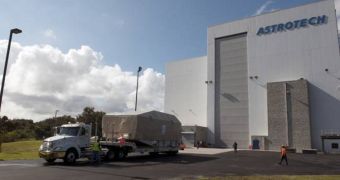Officials with the American space agency announce that the second third-generation Tracking and Data Relay Satellite (TDRS) has just been delivered to the NASA Kennedy Space Center (KSC), in Florida, on Friday, December 6.
The spacecraft, called TDSR-L, is the second of the new series of spacecraft built by The Boeing Company's Space and Intelligence Systems division, in El Segundo, California. Previous models in the constellation were built by TRW Inc., a company that went bust in 2002.
Now that the new satellite has arrived at KSC from California, engineers can begin the complex procedure of attaching it to its carrier rocket, a United Launch Alliance (ULA) Atlas V heavy-lift delivery system that will fly in the popular 401 configuration.
Atlas V are known to be very reliable rockets, having already launched critically-important payloads such as the Mars Reconnaissance Orbiter, the New Horizons probe, the Lunar Reconnaissance Orbiter, the Solar Dynamics Observatory, the Boeing X-37B, the Juno probe and the Mars Science Laboratory.
Its newest payload, TDRS-L, is scheduled to launch from Florida on Thursday, January 23, 2014. The satellite arrived at the KSC aboard a United States Air Force (USAF) C-17 cargo aircraft. Engineers found no signs that the satellite had sustained any damage during flight.
This vehicle will be the latest in a long line of TDRS satellites that has been providing critical communications relays between NASA and its space exploration missions for more than 30 years. This constellation allowed data transfers to the space shuttles, and now supports the International Space Station (ISS) in low-Earth orbit.
“The launch of TDRS-L ensures continuity of services for the many missions that rely on the system every day,” explains the manager of the TDRS project, Jeffrey Gramling. The expert is based at the NASA Goddard Space Flight Center in Greenbelt, Maryland, which manages the TDRS constellation.
TDRS-L follows in the footsteps of TDRS-K, which was the first of the new series of spacecraft to be launched into space, in January 2013. The third spacecraft, TDSR-M, is currently on track for launch in early 2015. Eight of the 11 satellites launched in this constellation are operational at this point.

 14 DAY TRIAL //
14 DAY TRIAL //